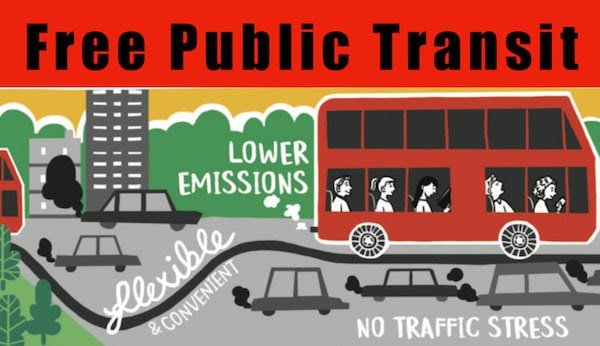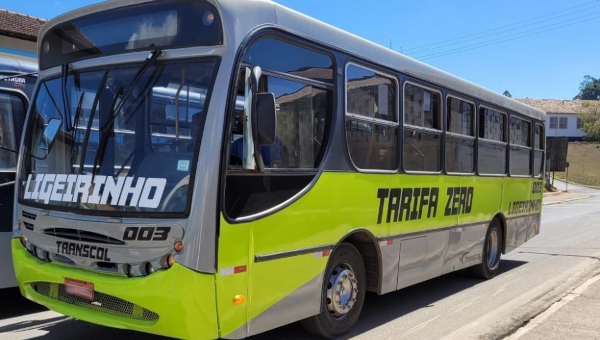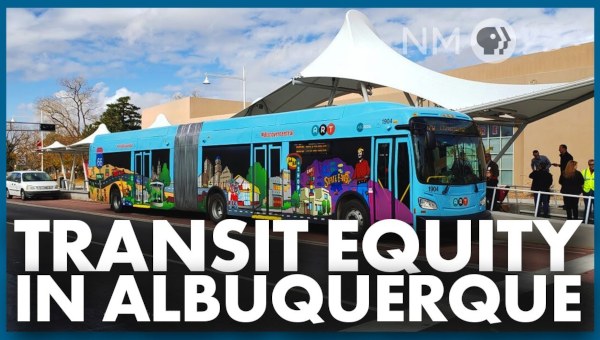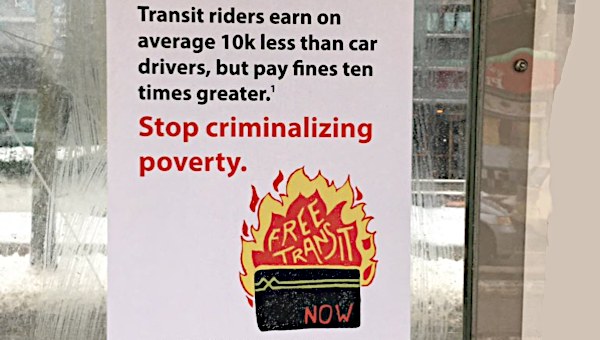Transport and the Climate Crisis: Lessons for the Left
On 11 December 2019, the EU Commission announced its Green Deal initiative. On the same day transform! europe and the GUE/NGL (European United Left–Nordic Green Left) conducted a conference on a socialist Green New Deal in the European Parliament. “New Deal” is meant to conjure up the spirit of Roosevelt’s famous plan of strengthening the social welfare state and, particularly, the power of trade unions. These two points are conspicuously absent in the EU’s Green Deal and were barely addressed by the Commission with only a few forced and reluctant suggestions for the ongoing protests by Fridays for Future, Extinction Rebellion, Ende Gelände (an alliance of anti-coal mining activists and climate activists) and other such social movements. It clearly falls to left-wing parties and radical social movements to actively pressure for a radical policy change. To put it bluntly, the Commission’s Green Deal has nothing to do with our vision of an ecological and feminist socialism. Nonetheless, the Green Deal does offer the Commission entry points toward left-wing policy.
The transition of the automotive industry to a sustainable and society-oriented mobility industry, one of the focal points of the Green New Deal, is currently vehemently stonewalled, especially by the grand coalition in Germany. However, the transformation of the mobility industry comprises far more than modernizing the automobile sector. Issues at hand include unnecessary, EU-subsidized provincial airports scattered across the landscape, badly equipped national railway lines, and nonsensical EU subsidy directives that obstruct the development of the public transport system, besides more insidious psychological barriers equalizing greater road networks and the lack of speed limits with personal freedom.
We are faced with many challenges when attempting to devise a left-wing model for the transportation sector. Jens Holm’s essay draws from his experience as Chairman of the Transport Committee of the Swedish Parliament. This reflection paper is part of transform! europe’s productive transformation project.
— Roland Kulke, January 2020
Accounting for almost one third of the EU’s total greenhouse emissions, the transport sector is the main contributor to today’s climate crisis. Moreover, carbon emissions are still booming despite both EU and national emission reduction targets. If business interests keep prevailing, we will have a huge increase in European transport-related emissions. The International Transport Forum predicts an increase of 100 per cent in personal transport and 300 per cent in goods by 2050. In this scenario the EU climate targets for 2030 and 2050 are in peril, in particular the already-too-modest goal of reducing transport-related emissions by 60 per cent by 2050 (White Paper on Transport 2011). We all understand that continuous emissions of carbon dioxide are a threat to our existence. To rely only on the possibility of a technological shift in the fields of biofuels and electricity is a huge gamble. The Left needs a strategy toward fixing the transport problem shift with an eye toward social inclusion and zero emissions. Although such a strategy does not yet exist, the following list includes some ideas for discussion toward the development of such a strategy.
Get Rid of Cheap Fossil Fuels
 Today’s boom in the transport sector has been made possible by cheap fossil fuels. The aviation and shipping sector do not pay any environmental costs for the use of diesel, petrol and kerosene. As for road transports, there are mechanisms to internalize the environmental costs of fossil fuels in many European countries. This is good, but not enough. The Left must move beyond taxing externalities: the objective should be to get rid of fossil combustion engines altogether as soon as possible. We should welcome proposals on banning the sale of new fossil vehicles, such as the ones put forward in France, Sweden and Denmark, just to mention a few examples.
Today’s boom in the transport sector has been made possible by cheap fossil fuels. The aviation and shipping sector do not pay any environmental costs for the use of diesel, petrol and kerosene. As for road transports, there are mechanisms to internalize the environmental costs of fossil fuels in many European countries. This is good, but not enough. The Left must move beyond taxing externalities: the objective should be to get rid of fossil combustion engines altogether as soon as possible. We should welcome proposals on banning the sale of new fossil vehicles, such as the ones put forward in France, Sweden and Denmark, just to mention a few examples.
Nevertheless, taxing fossil fuels is an important measure until fossil fuel vehicles are banned altogether. However, as the example of the French gilets jaunes shows, it is important to have a fair tax design. Cap and dividend is a good principle in this respect. Could, for instance, a part of the revenues be used to subsidize marginalized areas, public transport, or even direct tax cuts and economical allowances for low-income persons? I am convinced that it is possible to simultaneously address both environmental problems and fairer wealth redistribution.
When it comes to aviation, the solution is simply to tax it as highly as possible. Some European countries (e.g. the UK, Germany and Sweden) have already imposed a tax on air flights. The Swedish tax was implemented last year, and since then both domestic and international flights decreased for the first time in decades. The aviation tax can therefore be considered a success. A tax on aviation is by definition a very fair tax, since high-income earners are the most frequent flyers. A progressive tax, such as the one proposed in the campaign A Free Ride, in which the price of tickets increases with the amount of flights that are carried out during a year, would be even fairer possibility. It is also possible to have a higher tax on business tickets, as seen in the UK. All this would reduce emissions, increase revenues to the state and have an even greater impact on fair economical distribution. Another simple solution is to tax aviation fuels. At the moment they are non-taxable due to the WWII-era ICAO Chicago Convention, which exempted fuels related to aviation from taxation. However, the convention dates back to 1944, long before the climate debate and Paris Agreement. The Left needs to push the EU and the ICAO to have such obsolete provisions scrapped altogether.
When it comes to the maritime sector, it is somewhat more complicated. Watercrafts stand for an increasing amount of the world’s emissions of greenhouse gases; however, this also because they are in charge of transporting the bulk part of the world’s export and import goods. More could be done in order to spur more local production to reduce cross-border transport, but trade will continue to exist in the future and therefore the shipping problem needs solutions. A simple one would be to switch from bunker oil to gas and from gas to electricity and hydrogen thereafter. Ports should also enforce much stricter environmental criteria for entry. Compliance with new regulations on Sulphur (SOx) and Nitrogen (NOx) will also lead to a total reduction of CO 2 gases. In this regard, the IMO/Helcom zone of the Baltic Sea to limit SOx and NOx could stand as an inspiring example.
Modal Shift – from Road to Rail
If sea transport is a good environmental alternative to road, rail is even better. In all transport conferences, there is consensus around the necessity for transporting more goods on rail and less on road. However, the current goes the other way, and market-driven concerns for speed do not make it easier. In Europe almost 80 per cent of the land freight transports are delivered by lorries and practically everything else is on rail (a small percentage goes on inland waterways). The trend is a continuous increase in road transport with the associated rising emissions. Even if freight transport goes down, transports will continue to take place. Therefore a modal shift from road to rail (and inner waterways, where possible) is a must.
Is it possible to make this happen? Let’s take a look at Europe’s premier transit country, Switzerland. In the year 2001, the Swiss government imposed the Heavy Goods Vehicle Charge, a tax on heavy lorry transports (over 3.5 tons). The purpose was to reduce the steady influx of heavy transports and protect the environment. In spite of a total growing pressure from the transport sector, the Swiss tax has actually managed to reduce the total number of heavy transports through the country. At the time of the tax introduction, more than one million transalpine transports were carried out yearly. Last year the number was down to 800,000, with the clear political ambition to decrease it even more. At the same time the market share for goods transport on rail increased, especially when compared to the alpine neighbour Austria, where transport via motorways is predominant. Additionally, the revenues from the tax go to the Swiss railway fund for further development of the rail infrastructure. The Swiss example shows that it is indeed possible to stop the increase of road transport and thus to make the modal shift from road to rail.
Solve Transport Crisis in our Cities
A large chunk of our emissions stem from transport in cities. More and more people want to live in urban areas because of urbanization. This is not necessarily a bad thing. Such a concentration of people in a limited area is a breeding ground for rational solutions. Well-developed public transport systems are the main strategy in this context. However, most of today’s metro, tramway, and suburban train systems were built during the post-war era and are today in desperate need of improvement. How, then, to reduce urban road transports and at the same time mobilize funding for public transport and cycling? Should this acute political issue be left in the hands of our local decision-makers?
Perhaps the Stockholm example with congestion charges could give some guidance? In Stockholm we made the biggest investment in our public transport system when, inspired by the London system (2003), we imposed the congestion charges 2006 (later congestion charges were turned into tax). The tax has been raised a couple of times since then, and generates today around 200 million euros yearly that goes to investments in the public transport system, in particular construction of 20 km of new metro lines with eleven new stations. The congestion tax managed to reduce urban car traffic in Stockholm for the first time and at the same time generated valuable revenues for public transport. The London system (and later the congestion tax in Gothenburg) follows the same pattern. From a class and gender perspective the congestion tax also favours structurally weaker groups, since wealthy men are over-represented in car transports and the working class and women are the ones that use public transport the most.
Free Public Transport – from Utopia to Reality
Speaking of urban public transport: would it be possible to have a transport service that is both first-rate and free of charge? After a public referendum in 2013 which achieved a resounding ‘Yes’ as a result, the capital of Estonia, Tallinn, became the first European capital (with the exception of Thorshavn, capital of the Faroe Islands) to impose free public transport. The free fare led to an increase in public travel by about 10 per cent (more in poorer areas of the city) and a reduction in car traffic. The reform was financed partly with higher parking fees in the city centre. Now other municipalities in Estonia are discussing following Tallinn’s example and making public transport free of charge. The French city of Dunkirk (about 90,000 inhabitants) implemented free public transport in 2018, apparently with considerable success. In addition, it has come to my knowledge that the discussion about free public transport is vibrant in countries such as Luxemburg and Germany. Many smaller towns in Europe already have free public transport, either for all citizens or for certain groups (children, students, pensioners). All of these examples are subject for further study.
 As good as it sounds, free public transport still looks like an utopia in most European cities. It simply costs a lot of money, and whatever funding there is needs to prioritize the enhancing of the service as such. Although this argument carries a lot of weight, it should be remembered that ticketing and control systems (such as the metro “head chopping” barriers in Paris and Stockholm) are not cheap either. In many regions of Europe, approximately 50 per cent of funding for public transport comes from tax revenue (the other half stem from ticket fees and sometimes other external funding). When that 50 per cent is used up, local politicians will often ask themselves, “if we are already funding 60 per cent of the service, why not take the extra mile and fund 100 per cent?” This was the case of Tallinn, where 65 per cent of public transport funding already came from tax revenue. It simply became easier and more rational to fund it wholly through taxes, like other social services.
As good as it sounds, free public transport still looks like an utopia in most European cities. It simply costs a lot of money, and whatever funding there is needs to prioritize the enhancing of the service as such. Although this argument carries a lot of weight, it should be remembered that ticketing and control systems (such as the metro “head chopping” barriers in Paris and Stockholm) are not cheap either. In many regions of Europe, approximately 50 per cent of funding for public transport comes from tax revenue (the other half stem from ticket fees and sometimes other external funding). When that 50 per cent is used up, local politicians will often ask themselves, “if we are already funding 60 per cent of the service, why not take the extra mile and fund 100 per cent?” This was the case of Tallinn, where 65 per cent of public transport funding already came from tax revenue. It simply became easier and more rational to fund it wholly through taxes, like other social services.
A task for the Left should be to find feasible ways of making free public transport possible. The fact that free public transport combines the goals of fair wealth distribution and environmental sustainability makes the struggle a worthy one for the Left.
Who Defines “Mobility”?
Mobility, linked with smart, green, eco, micro, modern, is one of the most frequent buzzwords in the transport sector today. New modes of transport keep popping up like daisies in spring; car sharing, carpooling, autonomous vehicles, electric bicycles and electric scooters – all of these could become important for the reduction of congestion and emissions. Nonetheless, it should not be taken for granted that new transport modes will automatically solve our problems. Without a clear political vision, these new features could become more of a burden than part of the solution.
Take electrical scooters as an example. One year ago, the scooter company Voi established itself in Stockholm pretty much overnight by placing more than thousand rental e-scooters in the central parts of the city. Swedish Voi was soon followed by other companies such as American Lime, German Tier, Circ and others, all of them backed by international venture capital. At the moment there are eight different scooter companies with a couple of thousand scooters competing on the streets, making the Swedish capital look like a salvage experiment for gig mobility economy. It could be argued that for many Stockholmers like myself, e-scooters have gone from being a fun and maybe necessary innovation to a huge nuisance. Why did this happen? Instead of becoming an integrated part of the public transport system, today e-scooters are scattered all over the place: in the streets, on bicycle lanes, dumped in the lake and canals (with batteries which become a local environmental hazard), and the list goes on. Hospitals reports record high numbers of casualties due to accidents with e-scooters (this summer we experienced the first death toll from an e-scooter accident, in southern Helsingborg). All this has taken place in the very centre of our capital, where space is very limited. Considering the chaos they have caused, we can say that e-scooters are the clear opposite of mobility, becoming instead a big hurdle, in particular for disabled persons. The scooters are not regulated at all. Responsible local politicians have said that since this is a completely new phenomenon they have no right to interfere, and the Swedish national government says it is up to the municipalities to regulate. In my opinion this illustrates the drawback of 100 per cent market-driven innovation lacking any form of political regulation (a more promising example is France’s recent regulation on “les trottinettes” as they are called).
Self-driving Cars – from Problem to Solution
The rental e-scooters may look as a marginal phenomenon, but soon we will have bigger challenges that can revolutionize our cities in a more profound way: self-driving cars. Several studies on autonomous vehicles have been carried out (e.g. OECD transport committee Urban Mobility System Upgrade, 2015), and they all point in the same direction: designed to complement public transport and not as a privately owned vehicle, self-driving cars can make the privately owned car superfluous. The OECD study concludes that 90 per cent of cars will disappear when city dwellers realize they do not need a car of their own, and that in a matter of minutes they can just call for an autonomous one that will bring them where they want. Studies from the KTH University in Stockholm point in the same direction. In the doctoral dissertation of Pierre-Jean Rigoles (2014), every self-driving car replaces 14 manual privately owned cars, and only one out of 20 parking spots will be needed in a scenario where shared autonomous vehicles are the norm. Rigoles also states that shared self-driving cars are very compatible with vehicle electrification. Autonomous and electric cars are a “perfect match,” he writes. Today a very big part of the space in our cities is dedicated to cars, roads and parking spots (25 to 60 per cent of the area, depending if we are in Europe or in North America). This is particularly inefficient when we consider that privately owned cars are not in use 96 per cent of the time, and when they are in use, they carry an average of only 1.2 persons. When 9 out of 10 cars become obsolete, you do not have to be a city planner to realize that a large portion of this space can be replaced with housing, playgrounds, parks, public institutions, etc. What an extraordinary vision for our cities!
On the other hand, without this vision and lacking the correct strategy, we may find ourselves in asphalted Gotham cities that are overcrowded with self-driving fossil-fuel cars delivering pizzas and picking up children from training; that is to say, many more cars than today.
Our main challenge is to put an end to emissions from the transport sector. If we reduce emissions, it is very likely that we will also achieve a better local air quality, which will benefit all, but in particular the working class and many marginalized neighbourhoods that are more exposed to air pollution and traffic noise. Making the transport system fairer, both from a class and gender perspective must go hand-in-hand with the struggle for the environment. As I have showed in the examples above, almost every single measure toward reducing transport emissions will also benefit the working class, young people and women. This makes for a fantastic opportunity to merge green and red.
Whether or not this becomes a reality – that is up to the Left to decide. •
Literature
This article first published on the transform-network.net website. Roland Kulke is facilitator of the productive transformation working group, and can be reached at kulke@transform-network.net.





